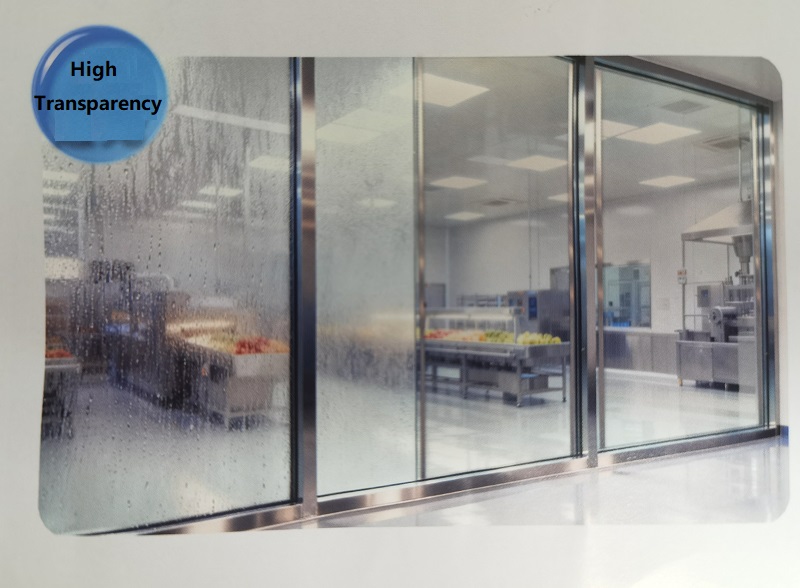Food factories operate in high-humidity environments where temperature changes are constant. Warm steam rises from production lines. Equipment is washed down several times a day. Cold rooms sit next to hot processing areas. Under these conditions, observation windows fog and drip almost every day.
A transparent heating film is a simple, effective way to keep these windows clear. Once installed, it warms the glass surface and stops condensation before it forms. This gives operators a stable view of the production line and reduces the need for frequent cleaning.
Fog appears when warm, moist air touches a cold glass surface. The surface cools below the dew point, and water droplets form instantly. In food plants, this happens for many reasons:
When moisture condenses faster than it evaporates, droplets begin to slide down the window. Over time, this creates a continuous drip that is difficult to control.

Fog and dripping water create real operational challenges:
In a facility that depends on efficiency and cleanliness, fogged observation windows create more work and reduce overall process stability.
Many food factories try anti-fog sprays, ventilation fans, or surface coatings, but these methods do not solve the root cause: glass temperature.
A transparent heating film works because it prevents condensation, rather than reacting after fog has already formed. It keeps the glass slightly warmer than the surrounding air, which completely removes the dew point problem.
Its advantages include:
It is also easy to fit into both existing windows and new equipment designs.
A transparent heating film uses a conductive layer — often ITO, metal mesh, or nano-silver — to generate gentle heat. This layer is almost invisible, so the window stays clear.
The working process is simple:
The film can be bonded directly onto glass or laminated between layers, depending on hygiene and cleaning requirements. Once installed, the system runs quietly in the background and keeps the observation window clear at all times.

Different factories face different humidity levels, cleaning routines, and temperature swings, so the heater must match the environment. Here are the main points to look at when selecting a transparent heating film for food processing rooms.
1. Heating Power Level
Different food-processing areas have different humidity loads. Light-steam rooms often need around 0.3–0.5 W/cm², while high-steam or cooking zones may require 0.6–1.0 W/cm² to stop fog on larger windows. Choosing the right power keeps the glass just above the dew point without wasting energy.
2. Optical Clarity
Observation windows must stay clear for inspection. High-quality films usually offer 85–92% visible light transmission, which keeps the view sharp even under bright lights. Lower haze values also help operators check color and equipment conditions easily.
3. Cleaning & Temperature Resistance
Food factories clean with hot water, steam, and chemicals. The heater should withstand 60–90°C washdowns and rapid temperature changes without peeling or losing adhesion. Good edge sealing also prevents moisture from entering the film.
4. Voltage Compatibility
Most factory equipment uses 12V, 24V, or 48V power systems. Matching the heater to your existing voltage keeps installation simple and ensures stable heating performance during long production shifts.
5. Size & Shape Requirements
Large windows cool faster and may need higher-power heaters, while small ports heat easily. If your window is round, curved, or irregular, a custom-cut heating film keeps the temperature even across the whole surface.
6. Control Method
Some factories use a simple switch. Others prefer thermostats or humidity-triggered controllers to reduce power use. Automatic control helps maintain consistent clarity and can cut energy consumption by 20–30%.

Every observation window, camera housing, or freezer panel is different. We design each transparent heater based on your exact size, voltage, shape, heating power, and installation method. From a small 5×5 mm heater to large panels, we support full customization.
Food processing steam, cold storage, washdown areas, vibration, and outdoor temperature swings demand strong materials. Our heaters resist:
We work with equipment manufacturers around the world in industries such as:
With strict testing, quick sampling, and responsive engineering support, we help you integrate the right heating solution smoothly and efficiently.
1. Can the heater run continuously during production?
Yes. Transparent heaters are designed for long hours of stable operation.
2. Will the heating film reduce visibility?
No. High-transparency materials keep the window completely clear.
3. Is it safe for food-grade environments?
Yes. The heater is sealed and compatible with food plant cleaning procedures.
4. How fast will the heater remove fog?
Most fog clears in seconds. Heavy moisture usually clears within a minute.
5. Can existing windows be upgraded?
Yes. Transparent films can be added to most existing glass panels without major replacement.
6. What voltage does the heater use?
Most designs use 12V or 24V, but custom options are available.
Simply drop your email or phone number in the contact form, and we'll promptly reply you shortly.